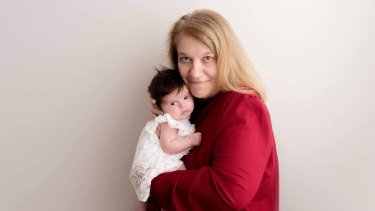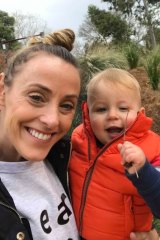Susan Bright sits cradling a baby in her arms singing lullabies. At 56, most would assume she is the baby’s grandmother; however, Susan is actually Matilda’s mother.
The Bunbury woman is one of an increasing number of Australians travelling overseas to fulfil their dreams of having a child.
Susan Bright, pictured with daughter Matilda, is one of an increasing number of Australians travelling overseas to fulfil their dreams of having a child.
Her quest began four years ago when her son died in a car crash days before his 32nd birthday.
“I didn’t have any chance of having grandchildren and a friend turned to me and said, ‘Well you still have the means to do something about that.’”
While the median age of pregnancy in Australia has risen, IVF statistics are sobering.
For women aged 40-44, the chance of a successful delivery per embryo transfer cycle is only 9.5 per cent, and that drops to 1.3 per cent for women over 45. In 2016, just six women had a live birth over 45 through IVF with their own eggs.
Susan was advised by IVF Australia that she was too old to be treated, so turned to Google and found a clinic in India offering donor eggs and sperm.
She took two trips to India and tried two different clinics; each quoting her a fee of around $7000 for a cycle of treatment. The first clinic, which she describes as modern, implanted three embryos. The second implanted a dangerously high number of four.
“The second transfer was a nightmare. They held me down and hurt me putting the embryos in. The clinic was very sub-standard. I wish I had just walked out and never done it,” she says. Neither treatment was successful.
It was her acupuncturist who told Susan about a clinic in Spain offering egg donation to women up to the day before they turned 57. She decided to give it one last go.
Susan was required to undergo an ECG, mammograms and blood tests and a Skype consultation with a doctor from the clinic in Spain.
After paying around $9000, four embryos were created from a 21-year-old egg donor and a sperm donor, and two were transferred. Five days later Susan returned to Australia where she found out she was to become a mum at the age of 55.
“I was in shock. I never expected it to work,” she says, adding that she was already post-menopausal when she conceived.
Susan suffered from gestational diabetes and placenta previa (each of which can occur to women of any age) during the pregnancy, however, she doesn’t feel her age has impacted upon her now she has a baby.
In fact, she’s so happy being a mother again, she is returning to Spain in October to have the remaining two embryos transferred. If successful, she will be 57 when she gives birth.
“People do think I am the grandmother. I sometimes get defensive but I do understand people look at me and think, ‘She is old. What is she doing with a baby?’”
Susan is only one of the Australian women travelling all over the world for egg donation. Medical director of IVF Australia, Dr Peter Illingworth, describes it as “very common”, although there are no statistics available.
Countries such as Greece, Spain, Russia, Ukraine, Prague and South Africa are all popular choices for Australian women seeking donor eggs and treatment.
Dr Illingworth says the lack of Australian egg donors, particularly younger ones, is driving women overseas where they have access to eggs from paid donors.
In Australia paying for egg donation is illegal, so recipients rely on altruistic donors who are generally in their 30s and have had their own families. An expert panel in Victoria, led by Alfred Hospital chair Michael Gorton, this week recommended public egg and sperm banks be created to make it easier for people to gain access to gametes or embryos.
Health Minister Jenny Mikakos said the government would consider all recommendations.
According to IVF Australia's Dr Illingworth, in New South Wales, "women risk breaking the law by going overseas for paid egg donation". However, no one has ever been prosecuted. He says "it will be a sad day when women are prosecuted for going overseas" and does not believe women are "defying" their biological age, as the population is living longer and the children are entering strong, secure and stable homes.
Natalie Hart, pictured with son Jenson, was 40 when she met someone she wanted to have children with.
Natalie Hart, from Melbourne, was 40 when she finally met a man with whom she wanted a long-term relationship. When she came off the pill and experienced a hot flush she knew something was not right.
An AMH, or "egg timer" test revealed she had less than 1 per cent of her egg reserve left. “I was devastated. It didn’t make sense,” says Natalie. Two attempts at IVF failed to produce any eggs.
“It was heartbreaking. It was like a nightmare,” she says.
Natalie's specialist said many of her patients were travelling overseas for egg donation, and recommended a clinic in South Africa.
“She said it was too hard in Victoria, unless you know someone young you can get eggs from, don’t waste your time here.”
Natalie and her fiancé were able to pick their own donor from a list given to them by the clinic. “It is a bit like a business transaction. You are not dealing with anyone else’s emotions except your own,” she says.
After a two-week holiday in Cape Town, the couple returned home with two embryos transferred and quickly discovered Natalie was pregnant.
Baby Jenson is now 17 months old, and Natalie, who is blissfully happy, plans to head back to Cape Town late next year to have the remaining embryo transferred.
“It makes no difference where that baby comes from. It is about experiencing being a mum and there is no other feeling like it,” she says.
Source: Read Full Article

